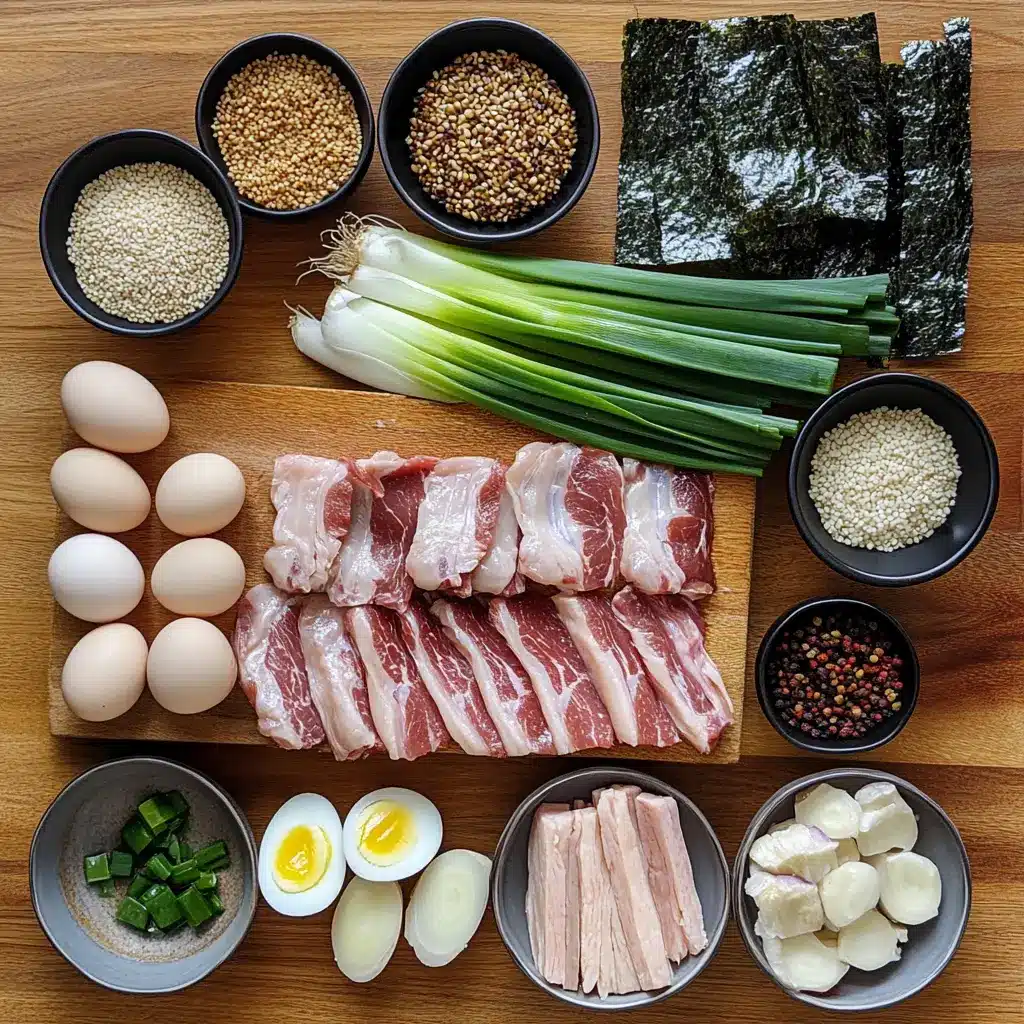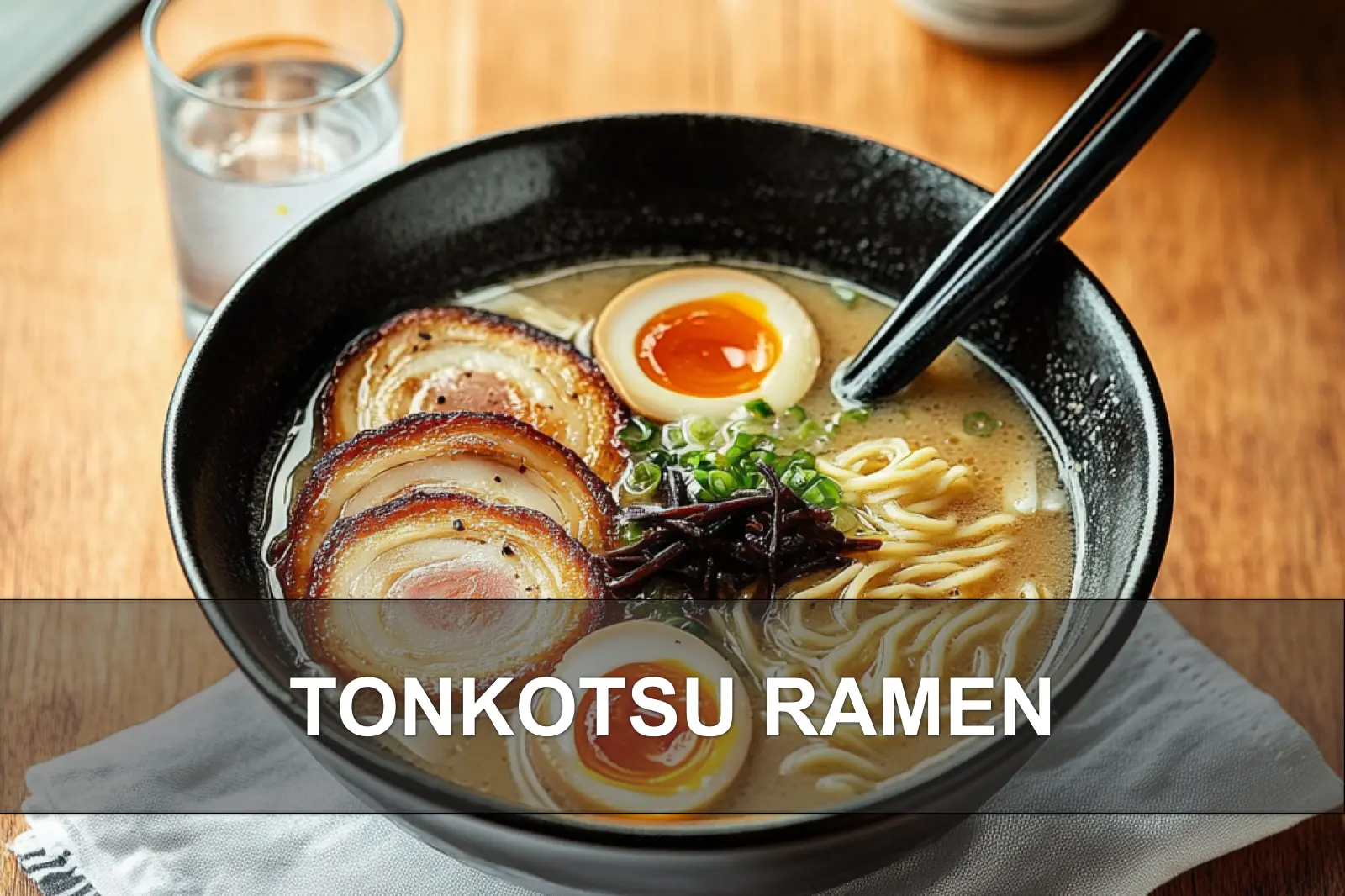You know that moment when you’re scrolling through your feed and suddenly crave something warm, rich, and absolutely soul-satisfying? That’s exactly what happened when Tonkotsu Ramen started trending everywhere – from TikTok food challenges to those gorgeous Pinterest boards filled with Japanese ramen aesthetic vibes. This isn’t your college dorm packet stuff, friends.
Think of it as the coziest hug in a bowl – rich, creamy pork broth meets tender noodles and all your favorite toppings. We’re talking soft-boiled eggs, green onions, and that melt-in-your-mouth pork belly that makes you close your eyes and sigh. It’s like chicken soup’s sophisticated Japanese cousin. Full details in the blog!
I’ve been perfecting this recipe for months because store-bought just doesn’t hit the same when you’re craving that authentic comfort. My family goes absolutely wild for this – even my pickiest eater asks for seconds. The secret? A little shortcut that gives you restaurant-quality results without the all-day commitment.
Why You’ll Love This Tonkotsu Ramen
This isn’t just another noodle soup – it’s pure comfort in a bowl that transforms your kitchen into a cozy Japanese ramen shop. The broth becomes this gorgeous, creamy white color that looks absolutely stunning in your favorite cute ramen bowl, perfect for those Instagram-worthy shots we all secretly love taking.
- Rich, restaurant-quality broth that’s worth every minute of slow simmering
- Customizable toppings so everyone gets their perfect bowl
- Makes amazing leftovers for busy weeknight dinners
- Impressive enough for dinner parties but cozy enough for family nights
What Makes This Broth So Special
The magic happens when pork bones and trotters slowly release their collagen during that long, gentle simmer. It’s like watching cream being stirred into coffee – the broth transforms from clear to this beautiful, milky white that’s the hallmark of authentic Tonkotsu Ramen.
The secret step: Blending those tender pork bits back into the broth creates an incredibly silky texture that coats every noodle. It’s what separates homemade from store-bought every single time.
| Timing Breakdown | What’s Happening | Kitchen Tip |
|---|---|---|
| First 20 minutes | Initial boil & cleaning | Don’t skip the scum removal! |
| Hours 1-4 | First long simmer | Check water levels every hour |
| Hours 5-6 | Final enrichment | Broth turns creamy white |
| Last 10 minutes | Assembly time | Warm your bowls first |
Your Essential Ingredients Guide
The beauty of this recipe is how simple ingredients create something extraordinary. Pork bones and trotters are your workhorses – they’re usually budget-friendly and available at most butcher shops or Asian markets.
Pro tip: Ask your butcher to crack the bones for you. It helps release more collagen and saves you the work at home. For the aromatics, don’t stress about perfect chopping – rough pieces work beautifully since we’re straining everything later.
| If You Can’t Find | Try This Instead | Notes |
|---|---|---|
| Pork trotters | Extra pork neck bones | Less collagen, but still delicious |
| Dried shiitake | Fresh mushrooms | Add during last 2 hours |
| Menma | Fresh bamboo shoots | Or skip entirely – still amazing |
| Leeks | Green onion tops | Use the white parts for topping |
Step-by-Step Magic
The first boil-and-drain step might seem fussy, but it’s what keeps your broth crystal clear before it turns that beautiful creamy white. Think of it as giving your bones a good rinse before the real cooking begins.
During those long simmering hours, your kitchen will smell absolutely incredible. The aromatics mellow out, and everything melds together into liquid gold. Don’t rush this part – low and slow is what creates that signature rich flavor.
- Hour 1-2: Broth stays relatively clear
- Hour 3-4: Color starts changing
- Hour 5-6: Full creamy transformation happens
Troubleshooting Your Broth
Broth not turning white? This usually means the heat was too low or the bones need more time. Bump up the heat slightly and give it another hour. Sometimes older bones take longer to release their collagen.
Running low on liquid? Just add hot water and adjust the seasoning at the end. It’s totally normal to need top-offs during that long simmer – don’t stress about it.
| Problem | Quick Fix |
|---|---|
| Broth too salty | Add hot water and simmer 15 more minutes |
| Not rich enough | Simmer uncovered to concentrate flavors |
| Cloudy (but not creamy) | Strain through fine mesh or cheesecloth |
| Fat layer on top | Skim with ladle or chill and remove |
Making It Your Own
Once you’ve mastered the basic Tonkotsu Ramen, the toppings are where you can get creative. Some nights I go traditional with soft-boiled eggs and nori. Other times, I raid the fridge for leftover roasted vegetables or different proteins.
Spice lovers: Add a dollop of chili oil or sriracha. Veggie boost: Corn, spinach, or mushrooms all work beautifully. The rich broth can handle whatever you throw at it.
Storage and Reheating
Here’s the beautiful thing – this broth actually gets better after a day in the fridge. The flavors settle and deepen, plus it makes weeknight dinners a breeze when you’ve got this liquid gold ready to go.
Fridge storage: The broth will get jiggly and gelatinous when cold – that’s exactly what you want! It means you nailed the collagen extraction. Just reheat gently and it’ll return to silky perfection.
| Storage Method | Timeline | Reheating Tip |
|---|---|---|
| Refrigerator | 3-4 days | Gentle reheat, don’t boil |
| Freezer | 2-3 months | Thaw overnight first |
| Leftover assembled bowls | 1-2 days | Store components separately |
Your Essential Ingredients

Expert Quote: The Secret to Authentic Tonkotsu Ramen
According to ramen chef Ivan Orkin, author of “Ivan Ramen”:
“True tonkotsu ramen requires at least 12 hours of boiling pork bones to achieve that signature creamy, collagen-rich broth. The milky white color comes from the fat and marrow being completely emulsified into the stock.”
This slow extraction process is what separates restaurant-quality tonkotsu from quick knockoffs patience creates that soul-warming, umami-packed base.
My Tonkotsu Ramen Story
I’ll be honest I never thought I’d master tonkotsu ramen at home until my teenage son challenged me after our favorite ramen shop closed. After countless bowls of trial and error, I finally cracked the code for that rich, creamy broth that doesn’t take all day. Now it’s our go-to comfort meal on busy weeknights.
For more delicious recipes and cooking inspiration, follow me on Facebook, Pinterest and Reddit!
FAQs ( Tonkotsu Ramen )
What is Tonkotsu Ramen?
Tonkotsu Ramen is a rich pork-bone broth ramen that originated in Fukuoka, Japan and is beloved in the USA for its creamy, milky soup. The broth gets its texture from simmering pork bones for many hours until collagen and marrow break down. Typical bowls include thin noodles, chashu pork, a soft-boiled egg, and green onions for balance. It is comfort food with deep umami and a silky mouthfeel.
Is Tonkotsu Ramen spicy?
Traditional Tonkotsu is not spicy; the focus is on a savory, creamy pork broth rather than heat. Many ramen shops and home cooks offer spicy add-ons like chili oil, rayu, or togarashi so you can dial in the heat you like. If you prefer a kick, add a spoonful of spicy paste or fresh chilies to your bowl. By default it is mild but easily customizable.
How long does it take to make authentic Tonkotsu broth?
Authentic Tonkotsu broth usually takes 12 to 18 hours of simmering to extract marrow and collagen that create the signature milky texture. Many home cooks use a pressure cooker to reduce the time to 3 to 4 hours while keeping much of the same richness. Active hands-on time is limited to skimming and occasional checks, but plan ahead for the long simmer. Make a big batch since the broth freezes well and is worth the effort.
Can I make Tonkotsu Ramen without a pressure cooker?
Yes, you can make Tonkotsu on the stovetop or in a slow cooker by simmering pork bones for many hours until the broth turns milky. Maintain a gentle, rolling simmer and skim impurities occasionally for a cleaner flavor. Use a heavy stockpot and be patient because the long cook time is what creates the signature richness. A slow cooker is a low-effort alternative if you want hands-off simmering.
How should I store and reheat leftover Tonkotsu Ramen?
Store broth and toppings separately in airtight containers in the refrigerator for up to 3 to 4 days to keep textures fresh. Freeze broth for up to 3 months for the best long term storage. Reheat broth over medium heat until simmering and add fresh noodles and toppings just before serving to avoid mushy noodles. This approach preserves the texture and flavor of your bowl.

Your Perfect Bowl Awaits
This Tonkotsu Ramen delivers that restaurant-quality richness you’ve been craving, right in your own kitchen. Yes, it takes time, but most of it’s hands-off simmering while you go about your day. You’ll love how that creamy, silky broth coats every noodle – it’s pure comfort food magic that’s worth every single minute.
Feel free to make it yours with different toppings or spice levels. I’ve tried everything from leftover roasted vegetables to a drizzle of sesame oil, and it all works beautifully. The broth keeps wonderfully in the fridge and honestly tastes even better the next day – perfect for quick weeknight dinners when you want something special without the fuss.
I’d love to see your cute ramen bowl creations! Tag me in your photos and let me know what toppings became your family favorites. Did this bring back any cozy food memories for you? There’s something magical about slurping noodles that just makes everything feel right with the world.

Tonkotsu Ramen: Best and Delicious Guide You Need
Ingredients
Method
- In a large stock pot add pork trotters and pork bones then fill with enough water to cover. Bring to a boil and boil until scum appears on top. Turn off heat and drain.
- Clean the pork bones and trotters under running water, removing any remaining scum.
- In a clean stock pot, heat oil then sauté onion, garlic, and ginger until fragrant.
- Add pork trotters, pork bones, leeks, dried shiitake mushrooms, and salt. Cover with 4 to 5 liters of water, cover pot with a heavy lid, bring to a boil.
- Reduce heat to simmer and cook for 4 hours, checking water levels and topping up as needed.
- After 4 hours, turn off heat and strain the broth through a fine sieve into another pot, reserving the bones.
- Ensure you have at least 3 liters of stock; add water if necessary. Bring the stock to a boil then reduce to a simmer.
- Scrape off tender fat and skin from pork trotters to make about 1 1/2 cups of pork skin. Puree with a hand blender until smooth.
- Add pureed pork skin to the simmering broth and continue simmering for 2 more hours. Season with salt and turn off heat.
- Cook ramen noodles according to package instructions.
- Place cooked noodles in a cute ramen bowl, pour over the rich pork broth.
- Top with sliced chashu pork, boiled eggs, chopped spring onions, nori squares, and optional menma for the perfect presentation and taste.
Notes
- For best results, use high-quality ramen noodles to complement the rich broth. You can prepare chashu pork a day ahead. Leftover broth can be refrigerated for up to 3 days or frozen for 1 month.









